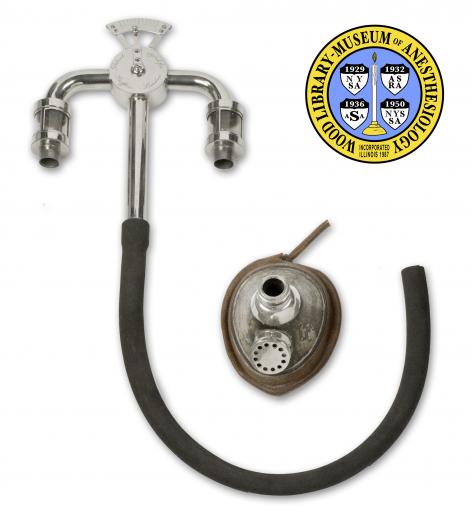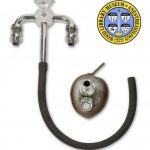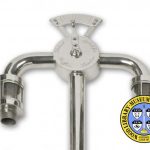Vernon Harcourt Inhaler
Dr. A. G. Vernon Harcourt (1834-1919) was an English chemist and a member of the Chloroform Committee of the Royal College of Surgeons. Even while the safety of chloroform was hotly debated, doctors and patients much preferred it to ether. Chloroform does not explode, and less of it is needed to produce anesthesia, lowering the severity of post-operative complications, such as nausea. But undesirable outcomes could not be ignored, and the ease of overdosing was part of the problem. Harcourt studied the body's metabolism of chloroform, and introduced this inhaler in 1899. The valves permit delicate control over the amount of chloroform that is used. It is also designed to be held in place with one hand, leaving one hand free for other tasks. This "pocket" version has a carrying case to protect the inhaler's fragile parts. Portability was essential, because in those days, doctors traveled to their patients.
Catalog Record: Vernon Harcourt Inhaler
Access Key: aile
Accession No.: 2001-01-26-1
Title: [Vernon Harcourt chloroform inhaler : pocket model / designed by A.G. Vernon Harcourt.]
Author: Harcourt, Vernon A. G. (Augustus George), 1834-1919.
Title variation: Alt Title
Title: Vernon Harcourt regulator.
Title variation: Alt Title
Title: Vernon Harcourtís apparatus for administering chloroform.
Title variation: Alt Title
Title: Harcourt inhaler.
Title variation: Alt Title
Title: Portable Vernon Harcourt chloroform inhaler.
Publisher: London : Griffin, [1903-1919].
Physical Description: 1 inhaler : nickel plated brass[?], rubber, glass, paint, tin[?], metal ; 4 x 25 x 19 cm. (case) + 44 x 9.5 x 9 cm. (mask)
Subject: Inhalers, Anesthesia – Great Britain.
Subject: Anesthesia, Inhalation.
Subject: Chloroform.
Note Type: General
Notes: Title based on information provided by the source of acquisition and the WLM
name for the instrument.
Note Type: Citation
Notes: Buxton DW. Anaesthetics : Their Uses and Administration. Philadelphia: P.
Blakiston’s Son & Co., 1907:203-211.
Note Type: Citation
Notes: Buxton DW. Anaesthetics : Their Uses and Administration. Philadelphia: P.
Blakiston’s Son & Co., 1914:243-252.
Note Type: Citation
Notes: Howell WB. Experiences of an anesthetist at the front. Am J Surg : Anesth
Suppl. 1918;32(10)(anesth suppl):117.
Note Type: Citation
Notes: Tan TC, Black P. Sir Victor Horsley (1857-1916): pioneer of neurological
surgery. Neurosurgery:2002;50(3):607-612.
Note Type: Citation
Notes: Thomas KB. The Development of Anaesthetic Apparatus. Oxford: Blackwell,
1975:89.
Note Type: Physical Description
Notes: The portable chloroform inhaler consists of a head, accompanying parts, a
case, and an oronasal mask; The head of the inhaler consists of a
nickel-plated brass tube approx. 14 cm long with two side-arms; The side-arms
are also nickel-plated brass tubes, approx. 11 cm in length; When the inhaler
is viewed upright, the arms connect to the upper portion of the vertical tube
extend outward as if to form the letter ‘T’, and then gently curve 90
degrees downward; The end of each arm is capped with a glass and metal
reservoir which contains an inspiratory valve; At the intersection of the
central tube and the two arms is a 4.5 x 2.5 cm, nickel-plated-brass,
circular housing for the valve (also called the ëstopcockí) that controls the
fraction of flow from the arms; On the face of the valve-housing is a dial
with a pointer directed at an unnumbered scale; The scale, also nickel plated
brass, is above the circular housing, and has eleven tick-marks; The central
and two outer tick-marks are longer than the others; Engraved on the face of
the valve-housing are the following marks: “Patent applied for” and “Griffin.
London.”; Engraved on the back of the housing is, “No. 208”; The oronasal
mask is painted metal [tin or brass?] with an inflatable, red-rubber cushion;
The mask also has an expiratory valve protruding from the nasal end; The
paint on the mask is chipped and there is a small tear where the
inflation-tube extends from the oral end of the mask; This tube is broken off
where the metal stopcock and port were connected to it; The stopcock and port
are in the case; Also in the case is a metal tube [called the ìIncrease of
percentage tubeî by Buxton in his 1907 text], approx 5.5 x 1 cm dia. with “3”
marked at one end and “2.5” marked on the other end; The case also contains
rotating, metal tubing that connects the head to the mask or to tubing
connected to the mask; When rotated into a ‘U-shape’, the connecting-tube
measures approx. 10 x 8 x 2 cm; A 9 cm metal pin with 1.5 cm of threading and
a wing-nut are also in the case; The inhaler and its parts, with the
exception of the mask, can be carried in the accompanying [tin?) case; The
case has rounded corners and is approx. 4 x 25 x 19 cm; The black paint on
the case is worn and chipped.
Note Type: Reproduction
Notes: Photographed by Mr. William Lyle, July 15, 2010; The black rubber tubing used
for the photographic reproduction is not original to the instrument.
Note Type: Historical
Notes: A. G. Vernon Harcourt, a pioneer in physical chemistry, was recruited to
assist in the investigation of chloroform by the British Medical
Associationís Special Committee on Chloroform in 1901. While participating in
the committeeís studies he designed this inhaler to limit the amount of
chloroform delivered to the patient. The tic-marks on the scale for the valve
indicate the concentration of chloroform, from zero to two percent. Harcourt
intended for the inhaler to allow a maximum of two percent chloroform, but
included a tube that could increase the concentration up to three percent. He
and others hoped that controlling the concentration of chloroform delivered
to the patient would prevent chloroform related deaths. His design included
an option for the anesthetist to hang the inhaler on his upper chest from a
neck-strap. Although a number of physicians were happy with the Harcourt
inhaler, including the accomplished surgeon Sir Victor Horsley (Tan & Black,
2002), there were also complaints, including prolonged induction times and
decomposing rubber on the masks (Howell, 1918 ; Thomas, 1975).
Note Type: Publication
Notes: Drury PME. Vernon Harcourt and his inhaler. Hist Anaesth Soc Proc.
2002;30:29-33.
Note Type: Publication
Notes: Report of Special Chloroform Committee. Brit Med J. 1910;Suppl 2:47-72.
Note Type: Publication
Notes: Shorter J. A. G. Vernon Harcourt: a founder of chemical kinetics and a
friend of “Lewis Carroll”. J Chem Educ. 1980;57(6):411-416.



